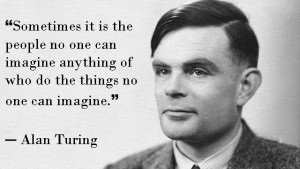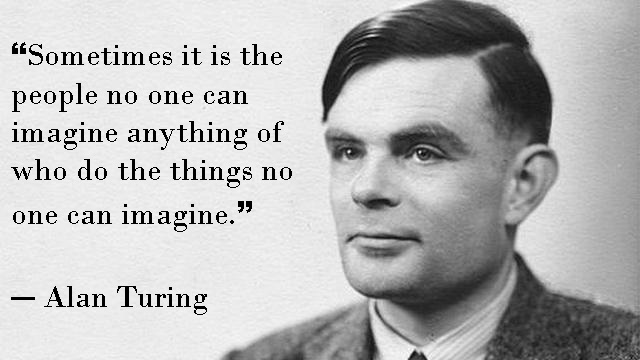Alan Mathison Turing (June 23, 1912 – June 7, 1954), known nowadays as the father of modern computer science and artificial intelligence, British former computer expert, mathematician, logician and cryptanalyst. Alan Turing invented a device(Turing machine) based on working with numbers 0 and 1 that formalized the concept of algorithm and calculus.
In 1999, journalists of TIME used to consider Alan Turing, one of the most important 100 people of XX century and the editors of Nature concluded the fact that “Alan Turing is, without any doubts, the only person that has made important contributions, that changed the world, in the finest types of intelligence: human, artificial and military intelligence”.
In the Second World War, Alan Turing had an important role in developing techniques of breaking German codes alongside the Bletchley Park team, techniques that, according to historians, have saved million people’s lives, by shortening the war in Europe with two to four years.
After The Second World War, Turing configured one of the first computer projects with a programme stocked as –ACE (Automatic Computing Engine), in partnership with National Physical Laboratory.
In 1936, Alan Turing invented a hypothetical device, representing a computing machine called “a- machine” (automatic machine). A Turing machine helps computer scientists to understand the limits of mechanical calculations, by manipulating the symbols (according to a rule table), with the possibility to be adapted in order to simulate the logic of any computer that can be built.
In 1948, Turing started to collaborate with Max Newman at the Computing Lab of the University of Manchester, where he was part of developing Manchester computers and became interested in mathematical biology. In this period, he wrote an article about the chemical bases of morphogenesis, anticipating oscillating chemical reactions (Belousov-Jabotinski reaction), that have been observed for the first time in 1960. The primary interest of Alan Turing in the domain of mathematical biology was understanding the phyllotaxy of Fibonacci, the existence of Fibonacci’s numbers in plant structures.
In 1950, Turing explored the artificial intelligence domain. He began with the fact that it is difficult to define intelligence but we can say that humans are intelligent. So, if another creature would act as a human being , we could say that it is intelligent. Obviously, not all the elements of the human behavior are relevant in defining intelligence. Power of decision and natural language can define intelligence while walking and reproduction cannot.
Turing invented the test that bears his name, based on the capacity of a machinery to sustain a conversation. He began with the “imitation game”, with three players: a man (A), a woman (B) and a third person (C). C is not in the same room with A and B and, communicating in writing or through a computer terminal, C has to guess who is the man and who is the woman. The role of the first player (A) is to trick the referee so that he take a wrong decision; the role of the other player (B) is to help the referee to take the right decision.
Turing replaced the first player (A) with a computer (a computer programme), and B and C with other two people. This time, C doesn’t know which one of the players is the computer and he cannot see them or speak to them, and the purpose is to distinguish between a conscious man and a machine, based on answers of any kind of questions. If C doesn’t succeed, then that computer can be considered to be intelligent. In order to pass a well done Turing test, the computer has to use natural language, reason, to acquire knowledge and to be able to learn from previous experiences.
Alan Turing published the paper work Computing Machinery and Intelligence that begins with the claim: “I propose to consider the question: Can machines think? ” where he argued against all objections the idea that “machines can think”. So from 1950, the test proved to be extremely powerful but also severely criticized and it represents an essential concept in the philosophy of artificial intelligence.
Alan Turing has predicted that the machines would be able at some point to pass the test; actually, he estimated that until 2000, the machines with a memory of 120 MB could trick 30% of human referees in a five-minute test. He has also predicted that the machine learning would become an important part of building a powerful machine, this affirmation is plausible for the contemporary researchers.
Alan Turing died at 41, on June 7, 1954, by poisoning with an apple containing cyanide. He was found dead in his house by his maid.
A.M. Turing Award is an award tendered every year by the Association for Computing Machinery to a chosen person for her utmost significant technical contributions brought to the computer science community. Turing Award is renowned to be “the highest distinction in computer science”.
Alan Perlins was the first winner in 1966 (from Carnegie Institute of Technology), and the first woman that won this prize ,in 2006, after 41 years of existence of A.M. Turing Award, was Frances E. Allen from IBM.
There is also a movie made about Alan Turing, called “The Imitation Game” (2014), with Benedict Cumberbatch as a protagonist, directed by Morten Tyldum, based on a book written by Andrew Hodges.
Daniela Anei (translated by Elena Golăi)
